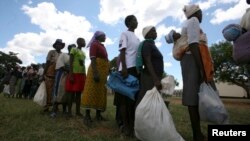HARARE —
The U.S. government has launched a five-year, $100 million program to assist more than a half-million hungry Zimbabweans.
At the launch of the new program, which is aimed at strengthening Zimbabwe's agricultural sector, U.S. Ambassador to Zimbabwe Bruce Wharton said Washington remained committed to the welfare of Zimbabweans.
“The United States wants Zimbabwe to prosper. Our joint efforts on food security are an opportunity for Zimbabweans in drought-prone areas to become more self-reliant," he said. "It will include vulnerable households having greater income options. It will include access to irrigation and clean water sources through rehabilitation and the rehabilitation of the existing schemes.”
Non-profit international development organizations World Vision and CNFA will implement the five-year program in Zimbabwe's most drought-prone provinces — Manicaland, Masvingo, Matabeleland North, and Matabeleland South.
The two NGOs will receive funds from the United States Agency for International Development.
Seasonal humanitarian assistance has become the norm in Zimbabwe since 2000, when agricultural production began a long-term plunge. Authorities blame the trend on drought, while critics of President Robert Mugabe blame his land reforms.
George Kembo of Zimbabwe’s Food and Nutrition Council says the U.S. program might finally be the answer to Zimbabwe's chronic food shortages and malnutrition.
“This program is moving away from giving rations," he said. "It is also tailor-made to activities happening within respective districts. What it is doing is to spruce up, to harness, to ensure that the communities continue doing what they were doing but with assistance. They are coming up and saying, "What is your strength? If you are into livestock, how do we support you so that you have more of those activities?”
Zimbabwe is in the grip of the "hunger season," the last three months before harvest.
The U.N. World Food Program is attempting to raise $86 million to feed more than two million hungry Zimbabweans.
At the launch of the new program, which is aimed at strengthening Zimbabwe's agricultural sector, U.S. Ambassador to Zimbabwe Bruce Wharton said Washington remained committed to the welfare of Zimbabweans.
“The United States wants Zimbabwe to prosper. Our joint efforts on food security are an opportunity for Zimbabweans in drought-prone areas to become more self-reliant," he said. "It will include vulnerable households having greater income options. It will include access to irrigation and clean water sources through rehabilitation and the rehabilitation of the existing schemes.”
Non-profit international development organizations World Vision and CNFA will implement the five-year program in Zimbabwe's most drought-prone provinces — Manicaland, Masvingo, Matabeleland North, and Matabeleland South.
The two NGOs will receive funds from the United States Agency for International Development.
Seasonal humanitarian assistance has become the norm in Zimbabwe since 2000, when agricultural production began a long-term plunge. Authorities blame the trend on drought, while critics of President Robert Mugabe blame his land reforms.
George Kembo of Zimbabwe’s Food and Nutrition Council says the U.S. program might finally be the answer to Zimbabwe's chronic food shortages and malnutrition.
“This program is moving away from giving rations," he said. "It is also tailor-made to activities happening within respective districts. What it is doing is to spruce up, to harness, to ensure that the communities continue doing what they were doing but with assistance. They are coming up and saying, "What is your strength? If you are into livestock, how do we support you so that you have more of those activities?”
Zimbabwe is in the grip of the "hunger season," the last three months before harvest.
The U.N. World Food Program is attempting to raise $86 million to feed more than two million hungry Zimbabweans.







